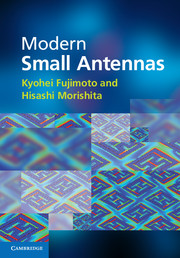Book contents
- Frontmatter
- Contents
- Preface
- Acknowledgements
- 1 Introduction
- 2 Small antennas
- 3 Properties of small antennas
- 4 Fundamental limitations of small antennas
- 5 Subjects related with small antennas
- 6 Principles and techniques for making antennas small
- 7 Design and practice of small antennas I
- 8 Design and practice of small antennas II
- 9 Evaluation of small antenna performance
- 10 Electromagnetic simulation
- 11 Glossary
- Index
- References
10 - Electromagnetic simulation
Published online by Cambridge University Press: 05 January 2014
- Frontmatter
- Contents
- Preface
- Acknowledgements
- 1 Introduction
- 2 Small antennas
- 3 Properties of small antennas
- 4 Fundamental limitations of small antennas
- 5 Subjects related with small antennas
- 6 Principles and techniques for making antennas small
- 7 Design and practice of small antennas I
- 8 Design and practice of small antennas II
- 9 Evaluation of small antenna performance
- 10 Electromagnetic simulation
- 11 Glossary
- Index
- References
Summary
Concept of electromagnetic simulation
Generally, there are some analytical methods to obtain antenna characteristics. However, it can be difficult to obtain the characteristics of small antennas, because they are very limited in dimension and influenced quite sensitively by environmental conditions around them. In many cases, it is hard to verify the performance of small antennas by experiments. For example, when the size of the antenna is extremely small, the radiation resistance becomes too small to be determined accurately. Another case is where the antenna structure is so complicated that precise measurement becomes very difficult to perform.
Recently, antenna engineers have become able to rely on highly specialized electromagnetic (EM) simulators to develop and optimize antenna design [1, 2]. Computer-aided analysis and optimization have replaced the design process of iterative experimental modification of the initial design. Therefore, the EM simulators become of paramount importance in the efficient research and development of new small antennas. An accurate computer-aided design (CAD) could support a clear physical interpretation for characteristics of small antennas.
The operation of an EM simulator is based on the numerical solution of Maxwell’s equations in differential or integral form.
Antennas for small mobile terminals are typical small antennas in practice and the EM simulators are often used to design them. Here, the concept of electromagnetic simulation is described along with antennas for small mobile terminals.
- Type
- Chapter
- Information
- Modern Small Antennas , pp. 389 - 408Publisher: Cambridge University PressPrint publication year: 2014



